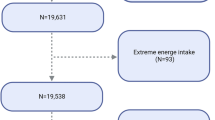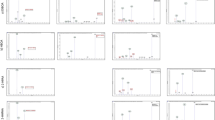Abstract
Background:
Alkylresorcinols (AR), a group of phenolic lipids present in the outer parts of wheat and rye grain kernels, have been suggested as biomarkers of whole-grain wheat and rye intake. In this study, we investigated potential determinants of plasma AR concentration in a free-living population.
Subjects/Methods:
Non-fasting samples from post-menopausal women enrolled in the Danish Diet, Cancer and Health study (n=360) were selected. Diet was assessed using a semi-quantitative food frequency questionnaires (FFQ) and the association between food items likely to contain AR and relevant non-dietary factors were studied by analysis of covariance models.
Results:
The median AR concentration was 78 nmol/l (interquartile range=106.9 nmol/l). Intake of rye bread, identified as the main determinant, was associated with 87% higher plasma total AR concentration per 100 g of bread (95% confidence interval=46–139%). About 8–12% of the total variation (depending on the AR homologue) in plasma AR concentration was explained by the selected dietary variables. At a nutrient level, total dietary fiber and cereal fiber were significantly associated with plasma total AR concentration (P=0.05), but only ≈2% of the total plasma AR concentration was explained by the dietary fiber or cereal fiber intake.
Conclusions:
In the studied population, AR plasma concentration was mainly affected by rye bread intake among investigated determinants.
This is a preview of subscription content, access via your institution
Access options
Subscribe to this journal
Receive 12 print issues and online access
$259.00 per year
only $21.58 per issue
Buy this article
- Purchase on SpringerLink
- Instant access to full article PDF
Prices may be subject to local taxes which are calculated during checkout

Similar content being viewed by others
References
Adams JF, Engstrom A (2000). Helping consumers achieve recommended intakes of whole grain foods. J Am Coll Nutr 19, S339–S344.
Aubertin-Leheudre M, Koskela A, Marjamaa A, Adlercreutz H (2008). Plasma alkylresorcinols and urinary alkylresorcinol metabolites as biomarkers of cereal fiber intake in Finnish women. Cancer Epidemiol Biomarkers Prev 17, 2244–2248.
Chen Y, Ross AB, Åman P, Kamal-Eldin A (2004). Alkylresorcinols as markers of whole grain wheat and rye in cereal products. J Agr Food Chem 52, 8242–8246.
Egeberg R, Frederiksen K, Olsen A, Johnsen NF, Loft S, Overvad K et al. (2009). Intake of wholegrain products is associated with dietary, lifestyle, anthropometric and socio-economic factors in Denmark. Public Health Nutr 12, 1519–1530.
Fung TT, Hu FB, Pereira MA, Liu S, Stampfer MJ, Colditz GA et al. (2002). Whole-grain intake and the risk of type 2 diabetes: a prospective study in men. Am J Clin Nutr 76, 535–540.
Greenland S (1995a). Dose-response and trend analysis in epidemiology: alternatives to categorial analysis. Epidemiology 6, 356–365.
Greenland S (1995b). Avoiding power loss associated with categorization and ordinal scores in dose-response and trend analysis. Epidemiology 6, 450–454.
Haraldsdóttir J, Tjønneland A, Overvad K (1994). Validity of individual portion size estimates in food frequency questionnaire. Int J Epidemiol 23, 786–796.
Horner NK, Kristal AR, Prunty J, Skor HE, Potter JD, Lampe JW (2002). Dietary determinants of plasma enterolactone. Cancer Epidemiol Biomarkers Prev 11, 121–126.
Hunter D (1998). Biochemical indicators of dietary intake. In: Willett WC (ed). Nutritional Epidemiology. Oxford University Press: New York. pp 174–243.
Jacobs DRJ, Marquart L, Slavin J, Kushi LH (1998). Whole-grain intake and cancer: an expanded review and meta-analysis. Nutr Cancer 30, 85–96.
Jansson E, Landberg R, Kamal-Eldin A, Wolk A, Vessby B, Åman P (2010). Accumulation of a potential whole grain biomarker (alkylresorcinols) in human adipose tissue. Br J Nutr 104, 633–636.
Johnsen NF, Hausner H, Olsen A, Tetens I, Christensen J, Bach Knudsen KE et al. (2004). Intake of whole grains and vegetables determines the plasma enterolactone concentration of Danish women. J Nutr 134, 2691–2697.
Kaaks R, Riboli E, Sinha R (1997). Biochemical markers of dietary intake. IARC Sci Publ 1997, 103–126.
Kilkkinen A, Stumpf K, Pietinen P, Valsta LM, Tapanainen H, Adlercreutz H (2001). Determinants of serum enterolactone concentration. Am J Clin Nutr 73, 1094–1100.
Koh-Banerjee P, Franz M, Sampson L, Liu S, Jacobs Jr DR, Spiegelman D et al. (2004). Changes in whole-grain, bran, and cereal fiber consumption in relation to 8-y weight gain among men. Am J Clin Nutr 80, 1237–1245.
Landberg R, Åman P, Adlercreutz H, Vessby B, Kamal-Eldin A (2008a). Dose response of whole-grain biomarkers: alkylresorcinols in human plasma and their metabolites in urine in relation to intake. Am J Clin Nutr 89, 290–296.
Landberg R, Åman P, Kamal-Eldin A (2009a). A rapid GC-MS method for quantification of alkylresorcinols in human plasma. Anal Biochem 385, 7–12.
Landberg R, Kamal-Eldin A, Andersson A, Vessby B, Åman P (2008b). Alkylresorcinols as biomarkers of whole grain wheat and rye intake: plasma concentration and intake estimated from dietary records. Am J Clin Nutr 87, 832–838.
Landberg R, Kamal-Eldin A, Andersson R, Åman P (2005). Alkylresorcinols in durum wheat (Triticum durum) kernels and pasta products. J Agric Food Chem 54, 3012–3014.
Landberg R, Kamal-Eldin A, Andersson S-O, Johansson S-E, Zhang J-X, Hallmans G et al. (2009b). Short-term reproducibility of plasma alkylresorcinols as biomarker for whole grain/bran wheat and rye intake. J Nutr 139, 975–980.
Landberg R, Kamal-Eldin A, Salmenkallio-Martilla M, Rouau X, Åman P (2008c). Localization of alkylresorcinols in barley, wheat and rye kernels. J Cereal Sci 48, 401–406.
Landberg R, Linko AM, Kamal-Eldin A, Vessby B, Adlercreutz H, Åman P (2006). Human plasma kinetics and relative bioavailability of alkylresorcinols after intake of rye bran. J Nutr 136, 2760–2765.
Linko A, Juntunen K, Mykkanen H, Adlercreutz H (2005). Whole-grain rye bread consumption by women correlates with plasma alkylresorcinols and increases their concentration compared with low-fiber. J Nutr 135, 580–583.
Linko-Parvinen AM, Landberg R, Tikkanen MJ, Adlercreutz H, Peñalvo JL (2007). Whole-grain alkylresorcinols are transported in human plasma lipoproteins, and their intake corresponds to plasma concentrations. J Nutr 137, 1137–1142.
Mattila P, Pihlava J-M, Hellström J (2005). Contents of phenolic acids, alkyl- and alkenylresorcinols, and avenanthramides in commercial grain products. J Agric Food Chem 53, 8290–8295.
Mejborn H, Biltoft-Jensen A, Trolle E, Tetens I, Ovensen L, Ygil K et al. (2008). Definition og vidensgrundlag for anbefaling af fuldkornsindtag i Danmark [Wholegrain-Definition and scientifica background for reccomendations in Denmark]. DTU Food- The National Food Institute. http://www.fuldkorn.dk/files/Rapporter/Fuldkorn%20definition%20og%20vidensgrundlag.pdf. Accessed on 6 September 2010.
Mellen PB, Walsh TF, Herrington DM (2008). Whole grain intake and cardiovascular disease: a meta-analysis. Nutr Metab Cardiovasc Dis 18, 283–290.
Milder IEJ, Kuijsten A, Arts ICW, Feskens EJM, Kampman E, Hollman PCH et al. (2007). Relation between plasma enterodiol and enterolactone and dietary intake of lignans in a Dutch endoscopy-based population. J Nutr 137, 1266–1271.
Montonen J, Landberg R, Kamal-Eldin A, Åman P, Knueppel S, Boeing H et al. (2010). Reliability of fasting plasma alkylresorcinol concentrations measured 4 months apart. Eur J Clin Nutr 64, 698–703.
Olsen A, Landberg R, Åman P, Kamal-Eldin A, Christensen J, Føns-Johnsen N et al. (2009). Plasma levels of alkylresorcinols and incidence of endometrial cancer. Eur J Cancer Prev 19, 73–77.
Overvad K, Tjønneland A, Haraldsdóttir J, Bang S, Ewertz M, Jensen OM (1991). Development of a semiquantitative food frequency questionnaire to assess food, energy and nutrient intake in Denmark. Int J Epidemiol 20, 900–905.
Priebe MG, van Binsbergen JJ, de Vos R, Vonk RJ (2008). Whole grain foods for the prevention of type 2 diabetes mellitus. Cochrane Database Syst Rev CD006061.
Rosner B, Willett WC (1988). Interval estimates for correlation coefficients corrected for within-persona variation- implications for study design and hypothesis testing. Am J Epidemiol 127, 377–385.
Ross AB, Kamal-Eldin A, Åman P (2004). Dietary alkylresorcinols: absorption, bioactivities, and possible use as biomarkers of whole-grain wheat- and rye-rich foods. Nutr Rev 62, 81–95.
Ross AB, Kochhar S (2009). Rapid and sensitive analysis of alkylresorcinols from cereal grains and products using HPLC-Coularray-based electrochemical detection. J Agric Food Chem 57, 5187–5193.
Ross AB, Oineau N, Kochhar S, Bourgeois A, Beaumont M, Decarli B (2009). Validation of a FFQ for estimating whole-grain cereal food intake. Br J Nutr 102, 1547–1551.
Ross AB, Shepherd MJ, Schupphaus M, Sinclair V, Alfaro B, Kamal-Eldin A et al. (2003). Alkylresorcinols in cereals and cereal products. J Agric Food Chem 51, 4111–4118.
Slavin J (2003). Why whole grains are protective: biological mechanisms. Proc Nutr Soc 62, 129.
Tjønneland A, Haraldsdóttir J, Overvad K, Stripp C, Ewertz M, Jensen OM (1992). Influence of individually estimated proportion size data on the validity of semi-quantitative food frequency questionnaire. Int J Epidemiol 21, 770–777.
Tjønneland A, Olsen A, Boll K, Stripp C, Christensen J, Engholm G et al. (2007). Study design, exposure variables and socioeconomic determinants of participation in diet, cancer and health: a population-based prospective cohort study of 57 053 men and women in Denmark. Scand J Public Health 35, 432–441.
Tjønneland A, Overvad K, Haraldsdóttir J, Bang S, Ewertz M, Jensen OM (1991). Validation of a semi-quantitative food frequency questionnaire developed in Denmark. Int J Epidemiol 20, 906–912.
van Dam RM, Hu FB (2008). Are alkylresorcinols accurate biomarkers for whole grain intake? Am J Clin Nutr 87, 797–798.
White E (1997). Effects of biomarker measurement error on epidemiological studies. IARC Sci Publ 142, 73–93.
Zarnowski R, Suzuki Y, Yamaguchi I, Pietr SJ (2001). Alkylresorcinols in barley (Hordeum vulgare L. distichon) grains. Z f Naturforch [C] 57, 57–62.
Acknowledgements
We thank BSc Erika Jansson for skilled technical assistance. This work was supported by the Swedish Governmental Agency for Innovation Systems (VINNOVA) and the Swedish Research Council for Environment, Agricultural Sciences and Spatial Planning (FORMAS), the Nordic Centre of Excellence (NCoE): HELGA.
Author information
Authors and Affiliations
Corresponding author
Ethics declarations
Competing interests
The authors declare no conflict of interest.
Additional information
Contributors: RL, AK-E, PÅ and AO planned the study. RL was responsible for the analysis of AR in plasma and drafted the paper. JC was mainly responsible for the statistical analysis. AT and KO were the founders of the cohort. All authors critically evaluated the paper before submission and RL was primarily responsible for the final content.
Rights and permissions
About this article
Cite this article
Landberg, R., Kamal-Eldin, A., Åman, P. et al. Determinants of plasma alkylresorcinol concentration in Danish post-menopausal women. Eur J Clin Nutr 65, 94–101 (2011). https://doi.org/10.1038/ejcn.2010.193
Received:
Revised:
Accepted:
Published:
Issue date:
DOI: https://doi.org/10.1038/ejcn.2010.193
Keywords
This article is cited by
-
Biomarkers of cereal food intake
Genes & Nutrition (2019)
-
New alkylresorcinol metabolites in spot urine as biomarkers of whole grain wheat and rye intake in a Swedish middle-aged population
European Journal of Clinical Nutrition (2018)
-
Dietary alkylresorcinols and cancer prevention: a systematic review
European Food Research and Technology (2017)
-
Carotenoids and alkylresorcinols as objective biomarkers of diet quality when assessing the validity of a web-based food record tool and a food frequency questionnaire in a middle-aged population
BMC Nutrition (2016)
-
Comparison of plasma alkylresorcinols (AR) and urinary AR metabolites as biomarkers of compliance in a short-term, whole-grain intervention study
European Journal of Nutrition (2016)



